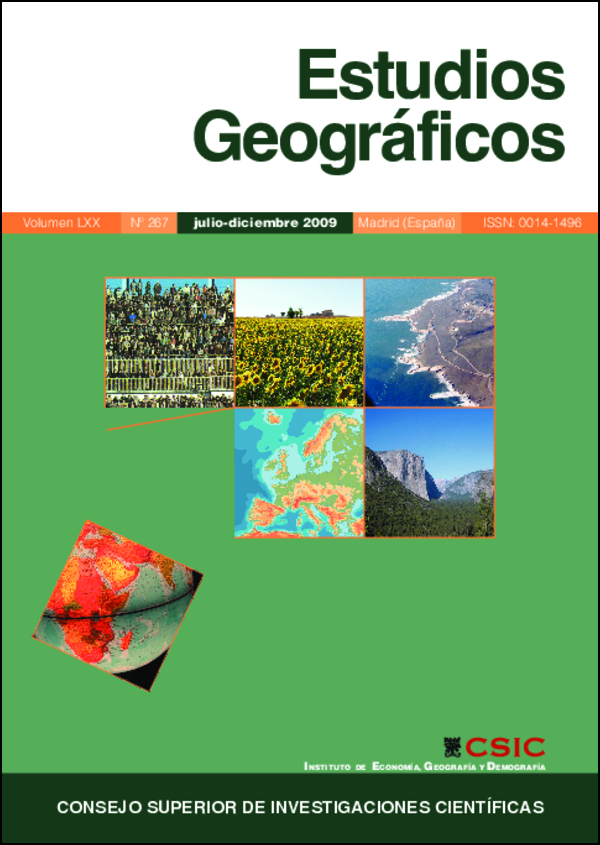Fertility in Europe, elements for a typology
DOI:
https://doi.org/10.3989/estgeogr.0466Keywords:
fertility, Europe, fertility calendar, birth out of marriage, inferlityAbstract
Fertility trends in Europe during the last half-century are marked by an important decline of level. If the continuous reduction of large families is not completely extraneous to this trend, changes in cohort fertility timing highly shape variations of the Total Period Fertility Rates. Firstly, rejuvenation of fertility timing has contributed to raise its level, then the reversal of this trend with women born just after the second world war and, as consequence, the increasing distance between cohorts have contributed to depress the TPFR level. Nowadays, fertility is on the way of stabilisation in a large number of countries. Most of the European countries have follow quite the same pattern, even if there was some calendar delay, especially in southern and eastern Europe, that could be reflect a general movement of behaviour homogenisation. However, during the last twenty years, divergent trends seem to have split western countries into several groups quite well differentiated. For this differentiation, two fertility modalities seem to have a very important effect: Out of wedlock fertility, which can compensate the decline of marriage, and the proportion of women remaining childless.
Downloads
References
Blayo, Ch., (1987): La fécondité en Europe depuis 1960: convergence ou divergence, in Actes du congrès européen de démographie, Central Statistical Office of Finland, pp. 47-111.
Blayo, Ch. et Bergouignan Ch., (2005): Fécondité et pression sociale en France dans les cinquante dernières années, in La population de la France. Evolutions démographiques depuis 1946. CUDEP, 884 p., édité par Bergouignan, Ch., Blayo, Ch., Parant, A., Sardon, J.-P. et Tribalat, M., pp. 273-332.
Frejka, T. et Sardon, J.-P., (2004): Childbearing Trends and Prospects in Low-Fertility countries: A cohort analysis, Kluwer Academic Publishers, European Studies of Population, n° 13, Kluwer Academic Publishers, p. 422.
Frejka, T. et Sardon, J.-P., (2007): Cohort birth order, parity progression ratio and parity distribution trends in developed countries, Demographic Research, Vol 16, n° 11, pp. 315-374. doi:10.4054/DemRes.2007.16.11
Sardon, J.-P., (1986): Evolution de la nuptialité et de la divortialité en Europe depuis la fin des années 1960. Population, n° 3, pp. 463-482.
Sardon, J.-P., (1991): Mariage et divorce en Europe de l’Est. Population, n° 3, pp. 547-598.
Sardon, J.-P., (1992): La primo-nuptialité féminine en Europe: éléments pour une typologie.¡ Population, n° 4, pp. 855-892.
Sardon, J.-P., (1998): Fécondité, bouleversements politiques et transition vers l’économie de marché en Europe de l’Est, Espace, Populations, Sociétés, n° 3, pp. 339-360.
Sardon, J.-P., (2003): Europe Centrale: Des trajectoires démographiques inquiétantes, Le courrier des pays de l’Est, Documentation française, pp. 27-42.
Zapf, W. et Mau, S., (1996): Eine demographische Revolution in Ostdeutschland?, Informationsdienst Soziale Indikatoren, 10: 1-5, cité dans Conrad C., Lechner M., Werner W., East German Fertility After Unification: Crisis or Adaptation?, Population and Development review, 22 (2), pp. 331-358
Downloads
Published
How to Cite
Issue
Section
License
Copyright (c) 2009 Consejo Superior de Investigaciones Científicas (CSIC)

This work is licensed under a Creative Commons Attribution 4.0 International License.
© CSIC. Manuscripts published in both the print and online versions of this journal are the property of the Consejo Superior de Investigaciones Científicas, and quoting this source is a requirement for any partial or full reproduction.
All contents of this electronic edition, except where otherwise noted, are distributed under a Creative Commons Attribution 4.0 International (CC BY 4.0) licence. You may read the basic information and the legal text of the licence. The indication of the CC BY 4.0 licence must be expressly stated in this way when necessary.
Self-archiving in repositories, personal webpages or similar, of any version other than the final version of the work produced by the publisher, is not allowed.















